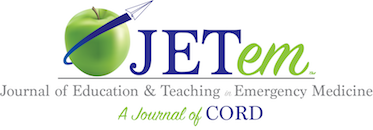Troubleshooting the Trach: Emergent Tracheostomy & Laryngectomies Modified Team-Based Learning Activity
ABSTRACT:
Audience:
Emergency medicine resident physicians (PGY1-4), medical students rotating in the emergency department
Introduction:
Tracheostomies are surgically created airways in the anterior of the neck to gain permanent or temporary access to the airway to facilitate oxygenation and ventilation.1Tracheostomies are performed for management of upper airway obstruction, long-term ventilation, and airway protection.1 More than 110,000 tracheostomies are placed annually in the United States.2 Emergency Medicine Physicians need to recognize and treat tracheostomy complications because they can occur 40-50% of the time in patients with tracheostomies.2 Most tracheostomy complications are minor, but up to 1% are considered life-threatening complications that pose a significant morbidity and mortality.2 Laryngectomies are rarer but are typically performed for carcinoma of the larynx, disrupting the connection to the oropharynx.1 While tracheostomies and laryngectomies are found in a similar location, the management is vastly different due to changes in anatomy. This modified team-based learning activity will review anatomy, history, and common presentations of tracheostomy patients in the emergency department.
Educational Objectives:
By the end of the session, participants will be able to: identify the major anatomy of tracheostomies and laryngectomies, 2) demonstrate step-by-step management of emergent tracheostomy airways, 3) describe common complications of tracheostomies, 4) understand the management of tracheal innominate artery complication.
Educational Methods:
This team-based learning activity is a modified TBL that includes learner responsible content (LRC), a multiple-choice group readiness assessment test (gRAT) with immediate feedback assessment technique (IF/AT), and a group application exercise (GAE).
Research Methods:
A post-TBL survey was provided to each participant. A Likert scale was used for the survey questions to assess the relevance of the session to emergency medicine practice, learner perception of knowledge gained, learner perception of improvement of clinical practice, session engagement, and session delivery.
Results:
For this session, 26 participants completed the post-TBL survey. Participants included 3rd/4th year medical students (19%), PGY1 (31%), PGY2 (23%), and PGY3 (27%) emergency medicine residents. Overall, 21/26 participants strongly agreed (5/5 Likert scale) and 4/26 agreed (4/5 Likert scale) that the session improved their knowledge of caring for tracheostomy patients with a weighted average of 4.78. Twenty-three participants (88.5%) strongly agreed (5/5 Likert scale) that the material in the TBL was relevant for practicing emergency medicine. The majority of participants (88.4%) found the session engaging. Narrative feedback included, “I am much more comfortable with trach complications.” Suggestions for improvement included, “would love to have time with a respiratory therapist to be available for questions during the session.” Narrative negative feedback included, “As a PGY-1, I haven’t had a lot of lessons on tracheostomies, so I felt a little useless during the application exercise.”
Discussion:
Airway emergencies for patients with tracheostomies and laryngectomies that are critical occur relatively infrequently. Given the rarity and high stakes of these events, it is important for emergency medicine trainees to have exposure to effective and high-yield learning activities which can aid in their preparedness to provide optimal care for patients presenting with tracheostomy-associated conditions.
This modified team-based learning (TBL) session facilitates discussion of pertinent anatomy and accurate equipment identification. Additionally, this session guides learners through a comprehensive step-by-step algorithmic approach to airway management for patients with a tracheostomy/laryngectomy presenting with obstruction, dislodgement, or tracheoinnominate fistula. Learners found the modified TBL (mTBL) to be beneficial for learning how to troubleshoot tracheostomy complications and manage these unique, challenging airway emergencies.
Topics:
Airway management, tracheostomies, laryngectomies, decannulation, obstruction.
